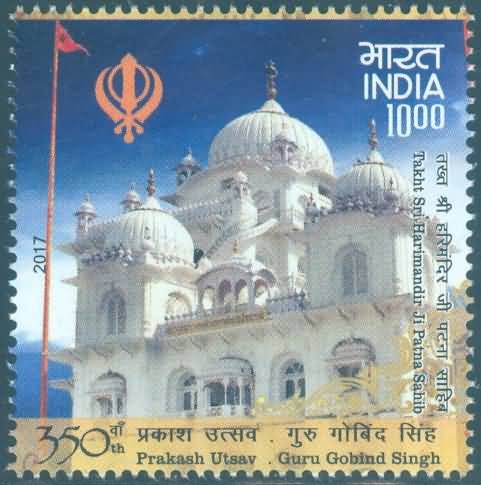Guru Gobind Singh, 350th Prakash Utsav

Technical Data
| Date of Issue | January 5, 2017 |
|---|---|
| Denomination | Rs. 10 |
| Quantity | 301,590 |
| Perforation | 14¼ |
| Printer | Security Printing Press, Hyderabad |
| Printing Process | Wet Offset |
| Watermark | No Watermark |
| Colors | Multicolor |
| Credit (Designed By) | Shri Kamleshwar Singh |
| Catalog Codes |
Michel IN 3084 Stamp Number IN 2895 Yvert et Tellier IN 2777 Stanley Gibbons IN 3243 |
| Themes | Anniversaries and Jubilees | Architecture | Buildings | Temples |
Birth and Early Life
Born on 22nd December 1666 in Patna, Bihar, Guru Gobind Singh Ji, the Tenth Guru of the Sikhs, was destined to shape the spiritual and social identity of his community forever. His father, Guru Tegh Bahadur Ji, the Ninth Sikh Guru, was then travelling through Bengal and Assam to spread the message of peace and righteousness. The home where young Gobind Rai (his birth name) was born is today one of Sikhism’s holiest sites — Takht Sri Harimandar Sahibji (Patna Sahib) — among the five sacred Takhts or seats of Sikh authority.
In 1672, Guru Gobind Singh Ji and his family moved to Anandpur Sahib, at the foothills of the Sivalik ranges, where he received a deep and diverse education. He mastered Punjabi, Sanskrit, Braj, and Persian, displaying not only intellectual brilliance but also spiritual wisdom far beyond his years. On Baisakhi, 29th March 1676, after the martyrdom of his father, Guru Tegh Bahadur Ji, Guru Gobind Singh Ji was formally installed as the Tenth Sikh Guru.
The Creator of the Khalsa – The Spirit of Courage and Equality
Guru Gobind Singh Ji is revered as the creator of the Khalsa Panth, a spiritual brotherhood of saint-soldiers committed to defending truth, justice, and righteousness (Dharma). On Baisakhi Day in 1699, at Anandpur Sahib, he initiated the Panj Pyare — the Five Beloved Ones — and then humbly received initiation from them himself, exemplifying true equality and humility.
The formation of the Khalsa gave new identity and strength to the Sikh community, emphasizing courage, devotion, and moral integrity. Guru Ji infused in his followers the dual spirit of saintliness and soldierhood — to meditate upon the One Supreme Being, to defend the weak, and to stand steadfast against tyranny and injustice.
Scholar, Poet, and Visionary
Guru Gobind Singh Ji was not only a warrior-saint but also a scholar and poet of exceptional genius. His compositions reflect profound spiritual insight and heroic valor. His first major work, Var Sri Bhagauti Ji Ki (Chandi di Var), written in 1684, narrates the cosmic battle between divine and demonic forces, symbolizing the eternal struggle between good and evil.
In works such as Chandi Charitra, he used vivid imagery and poetic brilliance to awaken the martial spirit among his followers, inspiring them to stand firm against oppression. His writings — compiled in the Dasam Granth — continue to guide generations with their message of devotion, moral discipline, and universal equality.
For Guru Gobind Singh Ji, poetry was a medium of divine revelation — a way to express the timeless relationship between the soul and the Supreme.
Legacy and Eternal Message
Before leaving his mortal form on 7th October 1708 at Nanded, Guru Gobind Singh Ji bestowed the Guruship upon the Guru Granth Sahib Ji, declaring it as the eternal Guru of the Sikhs — a living embodiment of divine wisdom and truth.
His life and teachings remain a beacon of courage, faith, and compassion. Guru Ji taught that true strength lies in righteousness, that spirituality and action must go hand in hand, and that every individual must rise above ego and serve humanity.
Even today, millions across the world draw inspiration from his message of equality, justice, and devotion to the One Creator.
Philatelic Tribute by India Post
To honor the enduring legacy of Guru Gobind Singh Ji, the Department of Posts issued a commemorative postage stamp, celebrating his life, teachings, and contribution to humanity. The stamp captures his divine presence — a radiant leader, poet, and warrior — who transformed spiritual devotion into an active force for justice and human dignity.
This philatelic issue stands as a tribute to the eternal flame of Sikh spirituality, reminding us of the values of courage, humility, and faith that Guru Gobind Singh Ji exemplified.
An Eternal Light for All Humanity
Through his words, actions, and sacrifice, Guru Gobind Singh Ji illuminated a path of righteousness that continues to guide humanity. His message transcends time, inspiring generations to live with truth, compassion, and courage.
The commemorative stamp by India Post immortalizes not just a leader, but a visionary who redefined the spirit of devotion and valor — the true Sant-Sipahi (Saint-Soldier) of India.
